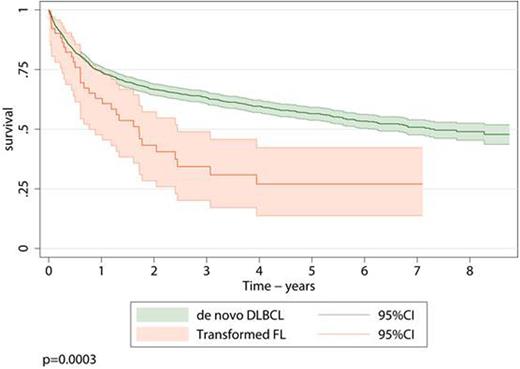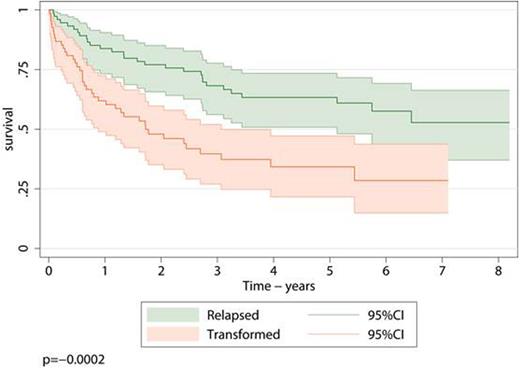Abstract
Transformation of follicular lymphoma (FL) is a morphological diagnosis based on the demonstration of diffuse large B-cell lymphoma (DLBCL) in a patient who has been diagnosed as having follicular lymphoma, either consecutively or concurrently. This is often regarded as having an adverse effect on prognosis compared to de novoDLBCL. However, a pathological diagnosis of transformed FL may be made in a range of quite different clinical settings and the aim of this study was to determine the extent to which this determined the prognostic significance of transformation.
The study was based on an established UK population cohort (www.hmrn.org), which since 2004 has tracked all patients diagnosed with haematological malignancies in a population of 3.6M. Within the study region, all tissue biopsies are handled by a single specialist haematopathology laboratory (www.hmds.info) and are investigated using morphology, immunocytochemistry, flow cytometry and molecular diagnostics according to standard protocols and WHO criteria. Clinical and treatment information is systemically collected for all patients and survival data is acquired through links with national data sources. Survival comparisons described below were adjusted for age and gender.
Morphological evidence of transformed FL, either concurrently or consecutively is not by itself an adverse prognostic factor when patients are treated with standard DLBCL chemotherapy. This result is consistent with previously reported studies that suggested that the presence of t(14;18) as a sole genetic abnormality had little effect on outcome in patients with DLBCL. However, when transformation occurs following prior exposure to chemotherapy the prognosis is poor. This group constitutes 8% of all FL patients, with most of these events occurring within 3 years of FL presentation. Further consideration is needed on how this group of patients should be managed.
Jack:Roche /Genentech: Research Funding. Off Label Use: Rituximab in Burkitts Lymphoma. Patmore:Roche: Consultancy, Honoraria.
Author notes
Asterisk with author names denotes non-ASH members.



This feature is available to Subscribers Only
Sign In or Create an Account Close Modal